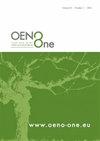A systemic approach to grapevine decline diagnosed using three key indicators: plant mortality, yield loss and vigour decrease
IF 2.2
3区 农林科学
Q3 FOOD SCIENCE & TECHNOLOGY
引用次数: 1
Abstract
Grapevine decline, a major global viticulture issue, is defined as a multi-year decrease in vine productivity and/or increase in vine mortality. Although grapevine trunk diseases are one of the most-studied causes, decline is multifactorial and associated with more than 70 factors, including abiotic and biotic hazards. With so many factors to consider, the phenomenon difficult to understand, especially for winegrowers. Our study aims to make it easier to determine and assess grapevine decline by focusing on three key indicators: yield, mortality and vegetative vigour. We investigated the relationships between these indicators from both a temporal and spatial perspective to propose a set of diagnostic indicators. Thus, we conducted a winegrowers’ survey, an historical analysis of grapevine decline and field measurements of the abovementioned indicators on plot networks in three major French winegrowing regions (see graphical abstract): Bordeaux, Cognac and Languedoc. We found that farmers’ perceptions of decline were consistent with an objective characterisation of decline based on in-field measurements of the indicators. Although vine mortality progressively spread over the years, neither the survey nor the historical analysis showed a direct link between decline and yield loss. Rather, large yearly fluctuations in yield, which did not systematically decrease over time, account for this finding. As a result, the mortality rate and the normalised difference vegetation index (NDVI) indicators were shown to be earlier indicators of grapevine decline than yield loss (yield achievement ratio, YAR). We performed a multifactorial analysis of the overall data set from the three regions to deepen our understanding of the variety of declining situations and the underlying environmental and management factors contributing to decline. Finally, two ground-based NDVI indicators and an image-analysis methodology using aerial photographs were proposed as easy-to-obtain indicators of grapevine decline. NDVI indicators were linearly correlated to both YAR and mortality rate. This study provides a better understanding and promising tools for early diagnosis of grapevine decline.使用三个关键指标诊断葡萄藤衰退的系统方法:植株死亡,产量损失和活力下降
葡萄产量下降是全球葡萄栽培的一个主要问题,它被定义为葡萄产量的多年下降和/或葡萄死亡率的增加。尽管葡萄藤干病是研究最多的原因之一,但其衰退是多因素的,与70多种因素有关,包括非生物和生物危害。考虑到这么多的因素,这种现象很难理解,尤其是对葡萄种植者来说。我们的研究旨在通过关注三个关键指标:产量、死亡率和营养活力,使确定和评估葡萄藤衰退变得更容易。我们从时间和空间的角度研究了这些指标之间的关系,提出了一套诊断指标。因此,我们对法国三个主要葡萄酒产区(波尔多、干邑和朗格多克)的葡萄种植户进行了调查,对葡萄产量下降进行了历史分析,并对上述指标进行了实地测量。我们发现,农民对下降的看法与基于实地指标测量的下降的客观特征是一致的。尽管葡萄树死亡率逐年增加,但调查和历史分析都没有显示产量下降和产量损失之间的直接联系。相反,产量每年的大幅波动并没有随着时间的推移而系统地减少,这说明了这一发现。结果表明,死亡率和归一化植被指数(NDVI)指标是葡萄产量下降的早期指标,而不是产量损失(产量成就比,YAR)。我们对来自三个地区的整体数据集进行了多因素分析,以加深我们对各种下降情况以及导致下降的潜在环境和管理因素的理解。最后,提出了两个基于地面的NDVI指标和一种使用航空照片的图像分析方法,作为易于获得的葡萄树衰落指标。NDVI指标与年增长率和死亡率均呈线性相关。本研究为葡萄藤衰退的早期诊断提供了更好的认识和有希望的工具。
本文章由计算机程序翻译,如有差异,请以英文原文为准。
求助全文
约1分钟内获得全文
求助全文
来源期刊

OENO One
Agricultural and Biological Sciences-Food Science
CiteScore
4.40
自引率
13.80%
发文量
85
审稿时长
13 weeks
期刊介绍:
OENO One is a peer-reviewed journal that publishes original research, reviews, mini-reviews, short communications, perspectives and spotlights in the areas of viticulture, grapevine physiology, genomics and genetics, oenology, winemaking technology and processes, wine chemistry and quality, analytical chemistry, microbiology, sensory and consumer sciences, safety and health. OENO One belongs to the International Viticulture and Enology Society - IVES, an academic association dedicated to viticulture and enology.
 求助内容:
求助内容: 应助结果提醒方式:
应助结果提醒方式:


